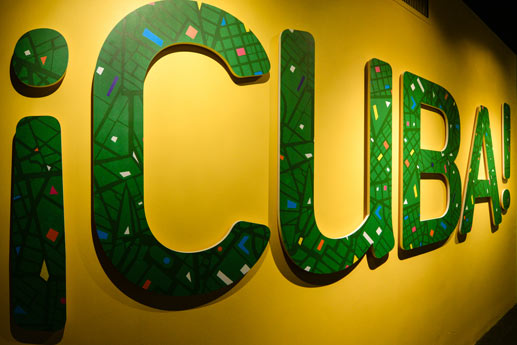¡CUBA! EXHIBITION TO OPEN AT COSI

COLUMBUS, OH - Cuba is a place of exceptional biodiversity and cultural richness, and now, a new bilingual exhibition set to open for a limited time at COSI. New in the American Museum of Natural History Special Exhibition Gallery at COSI, ¡Cuba! will be on view March 21 – September 7, 2020. The exhibition will offer visitors fresh insights into this island nation just 94 miles from Florida’s shores. With a close look at Cuba’s unique natural history, including its native species, highly diverse ecosystems, and geology, ¡Cuba! also explores Cuba’s history, cultural traditions, and contemporary Cuban voices to inspire novel perspectives on this dynamic country.
“¡Cuba! gives COSI visitors the opportunity to gain a new awareness about the fascinating and historically impactful island,” said Dr. Frederic Bertley, President and CEO of COSI. “This immersive exhibition not only offers a look at the unique cultural aspect of Cuba but also the incredibly unexpected biodiversity. From the vivid colors of its boulevards, to its mysterious caves, to its hard challenges, COSI visitors are certain to enrich their own understanding by discovering new aspects of Cuba.”
Technically an archipelago of more than 4,000 islands and keys, Cuba is the largest island nation in the Caribbean—and one of the region’s most ecologically diverse countries. About 50 percent of its plants and 32 percent of its vertebrate animals are endemic, meaning they are found only on the island. The exhibition will include live animals, specimens, and lifelike models representing the island’s distinctive wildlife, from a venomous mammal to the world’s smallest bird. Biodiversity displays were developed by the American Museum of Natural History in close collaboration with scientists at the Cuban National Museum of Natural History (Museo Nacional de Historia Natural de Cuba, MNHN). Highlights include a re-creation of the Zapata wetlands, home to the endangered Cuban crocodile, and a reconstructed cave environment.
The exhibition opens with life-sized portraits of modern Cubans paired with short excerpts from interviews, offering a chorus of voices—from Cuba and abroad, young and old, urban and rural, pragmatic and optimistic. A long, open boulevard evoking the street life one might find in a Cuban city will invite visitors to discover Cuban culture through music, games, and a variety of interactive experiences. Other highlights include a pair of altars celebrating orisha religion, an Afro-Cuban spiritual tradition also known as Santeria; a gallery showcasing contemporary Cuban art; and a display on the cultivation of one of Cuba’s most famous crops, tobacco. An introductory film about Cuba’s history—including its first peoples, slavery, sugar industry, and the 1959 revolution—will provide visitors with historical context for contemporary realities.
The American Museum of Natural History has long collaborated with Cuban scientists at a number of institutions, including the MNHN, the University of Havana, the Cuban Botanical Society, and the National Enterprise for the Protection of Flora and Fauna. Museum scientists have led and participated in nearly 30 expeditions and field projects to Cuba for more than 125 years.
Building on this long legacy, the American Museum of Natural History launched a research collaboration with Cuba under the banner of Explore21—a comprehensive Museum initiative that began in 2013 to foster a series of innovative scientific expeditions to meet the challenges and opportunities of the 21st century. In the fall of 2015, the Explore21 Expedition to Cuba sent a team of Museum and Cuban scientists to Alejandro de Humboldt National Park, one of the most remote and biologically important areas of the country, to advance the understanding of Cuban biodiversity, its evolution, biogeography, and conservation. ¡Cuba! will feature footage from the expedition’s survey.
The U.S. and Cuba share ecosystems and biodiversity, and face shared environmental challenges. For example, Cuba, which is located just 94 miles south of Florida, provides important wintering habitats for more than 280 bird species that breed in the United States. The two countries share 49 animal species and eight plant species that are characterized as “globally threatened” by the International Union for the Conservation of Nature and Natural Resources. And invasive species, like the red lionfish, prey on the native fish and disrupt ecosystems ranging from waters off of North Carolina all the way down to the Caribbean.
“We share environments and environmental interests,” said ¡Cuba! co-curator Ana Luz Porzecanski, director of the American Museum of Natural History’s Center for Biodiversity and Conservation. “Cuba’s nature has been protected both because of historical circumstance and because Cubans themselves have been very committed to protecting their biodiversity. Collaborations in education and research are critical, as they underpin conservation efforts and shape a sustainable vision of the future.”
¡Cuba! will look at the environmental challenges the country faces, as well as the many effective conservation laws and measures in place to preserve its unique landscape. As the political and economic relationship between the U.S. and Cuba continues to evolve, the exhibition aims to promote visitor understanding of Cuba’s history as well as its future.
“We really want to surprise visitors with details about Cuba that they’ve never thought about before,” said ¡Cuba! co-curator Chris Raxworthy, curator-in-charge of the American Museum of Natural History’s Department of Herpetology. “We hope this exhibition relays an understanding of who the people of Cuba are, how the island nation is biologically unique, how it is connected to the world, and what it’s like to live in Cuba now.”
Exhibition Organization
¡Cuba! is organized by the American Museum of Natural History, New York (amnh.org) in collaboration with the Cuban National Museum of Natural History.